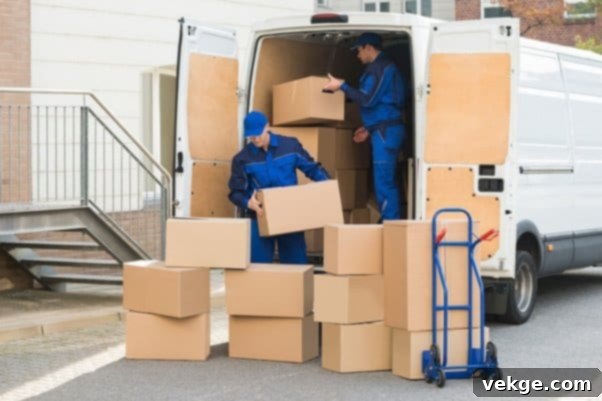Your Ultimate Guide to Choosing the Best Local Moving Company for a Stress-Free Move
Relocating to a new home, even within the same city, can be an exciting yet daunting experience. The success of your move largely depends on the choices you make, particularly when it comes to selecting the right local moving company. A professional and reliable team of local movers can transform a potentially chaotic day into a smooth, efficient, and even enjoyable transition.
This comprehensive guide is designed to equip you with all the essential information you need to navigate the process of finding, evaluating, and hiring the perfect local movers near you. We’ll delve into key factors that should influence your decision, provide practical advice for securing accurate estimates, highlight the importance of understanding costs, and offer vital tips for avoiding scams and preparing meticulously for moving day. Our goal is to empower you to make informed decisions, ensuring your next move is as stress-free and successful as possible.
By the end of this guide, you will have a clear understanding of what to look for in a moving company, how to manage your budget effectively, and what steps to take to protect your belongings and your peace of mind throughout the entire relocation process. Let’s make your move seamless!
Understanding Local Moving Companies and Their Services
The local moving industry offers a wide array of services designed to cater to various relocation needs, all within a specific geographic area. Understanding these services, as well as the nuances of cost and regulatory compliance, is the first step toward making an informed choice. Local moving companies specialize in helping individuals and families transition from one residence to another, typically within a 100-mile radius, though this definition can vary by state.
These professional local movers provide a spectrum of services that can include everything from basic transportation to comprehensive, full-service moves. Common offerings often encompass:
- Packing Services: From partial packing (e.g., just fragile items) to full-service packing where movers handle everything, including supplying all materials.
- Loading and Unloading: The core service, involving the careful loading of your belongings onto the moving truck and then unloading them at your new destination.
- Transportation: The secure transfer of your possessions from your old home to your new one using well-maintained moving vehicles.
- Disassembly and Reassembly: Assistance with taking apart large furniture items (beds, tables, shelving units) before the move and putting them back together at your new home.
- Specialty Item Handling: Expertise in moving delicate, oversized, or unusually shaped items like pianos, antiques, artwork, pool tables, or large appliances, often requiring specialized equipment and training.
- Storage Solutions: Many local moving companies offer short-term or long-term storage options, which can be invaluable if your new home isn’t immediately ready or if you need to declutter during the transition.
Companies like Daymakers Moving & Storage, for instance, are known for exemplifying this comprehensive approach, offering tailored services from portable storage solutions to specialized packing techniques for high-value items, ensuring every aspect of your move is covered. This level of specialization highlights the importance of finding a mover that matches your specific requirements.

Cost is, naturally, a primary concern for most individuals planning a move. Local movers typically base their charges on a combination of factors:
- Hourly Rates: Many local companies charge an hourly rate for the moving crew, often with a minimum number of hours. This rate usually includes the truck and basic equipment.
- Total Weight or Volume: For larger moves, some companies might base their estimate on the total weight or cubic footage of your belongings.
- Distance: While local moves are generally short-distance, the precise mileage can still influence the final cost.
- Additional Services: Packing materials, specialty item handling, shuttle services (if the large truck can’t access your home), long carry fees (if the truck has to park far from your entrance), and stair/elevator fees will add to the base cost.
- Seasonality: Moving during peak times (summer, weekends, end of the month) typically results in higher prices due to increased demand. Conversely, moving during off-peak times can offer cost savings.
For instance, a standard local move could range anywhere from $400 to $1,500, but these figures can fluctuate significantly based on the size of your home, the number of items, and the specific services you opt for. Understanding these variables allows you to better budget for your move and avoid unexpected expenses.
Furthermore, it’s crucial to acknowledge the legal and regulatory framework governing local moving companies. Depending on your state, movers must adhere to specific licensing, insurance, and operational regulations. These regulations are designed to protect consumers, ensuring movers operate ethically, maintain proper insurance coverage (like cargo liability and workers’ compensation), and adhere to safety standards for their equipment and personnel. Always verify a company’s licensing and insurance to ensure they are legitimate and accountable.
Key Factors to Consider When Choosing a Local Moving Company
Selecting the right local moving company requires careful consideration of several critical factors beyond just the price. A thorough evaluation will help you find a reliable, efficient, and trustworthy service provider that meets your specific needs and budget.

Reputation and Reviews
A company’s reputation is a strong indicator of its service quality and reliability. Start by checking customer reviews on independent platforms such as Google My Business, Yelp, the Better Business Bureau (BBB), and social media. Look for patterns in feedback – positive comments about professionalism, efficiency, and careful handling of items are good signs. Conversely, recurring complaints about hidden fees, damaged goods, or poor communication should raise red flags. Pay attention to how companies respond to negative reviews; a professional response shows a commitment to customer service and resolving issues.
Licensing and Insurance
This is arguably the most crucial factor. Ensure the moving company is properly licensed and insured. For local moves (within a state), check with your state’s Department of Transportation or consumer affairs office for licensing requirements. Insurance is essential for protecting your belongings. Movers typically offer basic liability coverage (e.g., $0.60 per pound per item), but you may want to purchase full value protection for more comprehensive coverage against loss or damage. Always ask for proof of insurance and understand what it covers before signing any contract.
Range of Services Offered
Evaluate whether the company’s services align with your specific moving needs. Do you need full packing and unpacking? Special handling for antiques or a piano? Storage solutions? Furniture disassembly and reassembly? Confirm that the company can accommodate all your requirements to avoid the hassle and additional cost of hiring multiple providers. A company offering a comprehensive suite of services can simplify your entire moving process.
Transparency in Pricing and Estimates
Reliable moving companies provide clear, detailed, and transparent estimates without hidden fees. They should offer an in-home or virtual estimate to accurately assess the volume and nature of your belongings. Differentiate between binding and non-binding estimates: a binding estimate guarantees the final price unless you add more items or services, while a non-binding estimate can change based on the actual weight or time taken. Always get your estimate in writing, detailing all services included and potential extra charges.
Experience and Expertise
How long has the company been in business? Experienced movers are generally more efficient, better equipped to handle unexpected challenges, and have a proven track record. Ask about their crews’ training and experience, especially if you have specialty items. A company with specific expertise in residential moves, for instance, might be a better fit than one primarily focused on commercial relocations.
Equipment and Resources
A professional moving company should have well-maintained trucks, appropriate moving equipment (dollies, blankets, straps, tools), and sufficient staff. This indicates their capability to handle your move safely and efficiently. Generic rental trucks or a lack of proper equipment can be warning signs.
How to Get Accurate Moving Estimates
Obtaining accurate estimates is paramount for budgeting your move effectively and avoiding unexpected costs on moving day. This process requires diligence and a clear understanding of what information movers need from you.
Firstly, get multiple estimates. It’s highly recommended to contact at least three to five different local moving companies. This allows you to compare services, pricing structures, and customer service quality. When requesting estimates, be as detailed as possible about your inventory.
The most reliable way to get an accurate estimate for a local move is through an in-home or virtual walkthrough estimate. Reputable movers will insist on this. During this visit, a moving consultant will assess the volume of your belongings, identify any specialty items that require extra care, evaluate access points at both your current and new homes (e.g., stairs, narrow hallways, long carries), and discuss any additional services you might need (packing, unpacking, storage).
- Be Prepared: Before the estimator arrives, make sure all areas of your home are accessible. Point out everything you intend to move, including items in closets, the attic, basement, garage, and outdoor sheds. Clearly indicate items you plan to discard, donate, or move yourself.
- Ask Questions: Use this opportunity to ask about everything included in the estimate. What is the hourly rate? How many movers will be on the crew? Is packing included? Are packing materials extra? What about insurance coverage? Are there any potential surcharges (e.g., for stairs, long carries, bulky items)?
- Understand Estimate Types:
- Binding Estimate: This is a fixed price that cannot change unless you request additional services or add more items. It provides cost certainty.
- Non-Binding Estimate: This is an approximation of the cost, and the final price can be higher or lower depending on the actual time, weight, or services rendered. While it offers flexibility, it comes with less financial predictability.
- Binding Not-To-Exceed Estimate: This offers the best of both worlds. The final price won’t exceed the estimate, but it could be lower if the move takes less time or the weight is less than anticipated.
Always get your estimate in writing, detailing every item, service, and cost. This document serves as a contract and protects you from potential disputes. By being proactive and meticulous during the estimation phase, you significantly increase your chances of a transparent and predictable moving cost.
The Cost of Hiring a Local Moving Company
The total cost of hiring a local moving company is influenced by a dynamic interplay of factors, making it crucial to understand how pricing structures work. While averages provide a general idea, your specific circumstances will dictate the final bill. On average, local movers typically charge hourly rates ranging from $25 to $100 per hour per mover, with many companies requiring a minimum number of hours, usually 2-4 hours. This means a basic local move for a smaller residence (like a studio or 1-bedroom apartment) might range from $200 to $800, but these figures can escalate quickly.

Key Factors Influencing Local Moving Costs:
- Size of Your Home: More items mean more time and potentially more movers. Moving a 3-bedroom house will naturally cost more than a studio apartment.
- Number of Movers: A larger crew can complete the job faster but will increase the hourly rate. Finding the right balance for efficiency is key.
- Distance of the Move: While local, longer distances within the local area will incur higher fuel and labor costs.
- Time of Year/Month/Week: Peak moving times (summer, end-of-month, weekends) are more expensive due to higher demand. Booking during off-peak times (mid-week, mid-month, fall/winter) can lead to significant savings.
- Additional Services:
- Packing and Unpacking: If you opt for professional packing services, this will be an extra charge, including labor and materials.
- Packing Materials: Boxes, tape, bubble wrap, and specialty containers all add to the cost.
- Bulky or Specialty Items: Moving items like grand pianos ($150-$550 locally), large safes, hot tubs, or complex exercise equipment often incurs separate charges due to the specialized skills and equipment required.
- Stairs or Elevators: Homes with multiple flights of stairs or locations requiring elevator usage might have “stair carry” or “elevator” fees.
- Long Carries: If the moving truck cannot park directly in front of your home and movers have to carry items a long distance, a “long carry” fee may apply.
- Disassembly/Reassembly: While some basic furniture disassembly might be included, complex items could lead to extra charges.
- Shuttle Services: If your new home is on a narrow street inaccessible to large moving trucks, a smaller shuttle truck might be used to transfer items, incurring an additional fee.
- Insurance: While basic liability is usually included, opting for more comprehensive full value protection will increase your overall cost.
To budget effectively, it’s highly recommended to get multiple, detailed, written estimates from different companies. Ensure these estimates clearly break down all potential fees. This allows for direct comparison and helps you negotiate or clarify any charges upfront, preventing unwelcome surprises on moving day. Remember to also factor in a tip for the moving crew, typically 15-20% of the total labor cost, for their hard work.
Avoiding Moving Scams and Ensuring Safety
Unfortunately, the moving industry, like many others, is not immune to fraudulent operators. Protecting yourself from moving scams is critical to ensure a safe, secure, and stress-free relocation. Vigilance and thorough vetting are your best defenses.
Red Flags to Watch Out For:
- Unusually Low Bids: If an estimate seems too good to be true compared to others, it probably is. Scammers often lure customers with lowball offers and then demand significantly more money once your belongings are loaded onto their truck (holding them hostage until paid).
- No In-Home Estimate: Reputable local movers will almost always offer an in-home or virtual assessment to provide an accurate estimate. Companies that give estimates solely over the phone or email without seeing your belongings are a major red flag.
- Large Upfront Deposits: Be wary of movers who demand a large cash deposit (e.g., more than 20-25%) before the move even begins. Most legitimate companies require little to no upfront payment, or a small deposit.
- Lack of Proper Identification/Paperwork: If the movers arrive in unmarked trucks, without uniforms, or refuse to provide proper paperwork (like a bill of lading or contract), proceed with extreme caution.
- Cash-Only Demands: A company insisting on cash-only payments, especially mid-move, is a significant warning sign. Legitimate businesses accept various forms of payment and provide receipts.
- No Physical Address or Generic Websites: Check if the company has a verifiable physical office address. Be suspicious of companies with only a PO box, an unprofessional website, or no online presence at all.
- Missing or Vague Insurance Information: A legitimate mover will be transparent about their insurance coverage and provide documentation. If they are evasive or offer only the most basic, inadequate coverage, reconsider.
Steps to Ensure Safety and Legitimacy:
- Verify Licensing and Insurance: For local moves, check with your state’s consumer affairs or transportation department for licensing requirements and to verify the company’s status. Always ask for proof of insurance and understand what it covers.
- Check Reviews and Complaints: Utilize sources like the Better Business Bureau (BBB), Yelp, Google reviews, and state consumer protection agencies. Look for consistent positive feedback and how the company addresses any negative comments.
- Get Everything in Writing: Ensure all agreements, estimates, and services are clearly documented in a written contract. Read every line before signing, especially regarding liability, insurance, and the final cost.
- Ask for References: A reputable company should be able to provide references from previous satisfied customers.
- Trust Your Gut: If something feels off or too good to be true, it probably is. Don’t let desperation for a cheap move lead you into a scam.
- Document Your Belongings: Create a detailed inventory of your items, especially valuable or fragile ones, and take photos or videos before the move. This provides evidence in case of damage or loss.
By being proactive and thorough in your research, you can significantly reduce the risk of falling victim to a moving scam and ensure a safe and secure relocation of your precious belongings.
Comprehensive Preparation for Moving Day
Effective preparation is the cornerstone of a smooth and successful move. Starting early and creating a detailed plan can alleviate much of the stress associated with relocation. This involves not only physical tasks but also administrative arrangements to ensure continuity in your new home.

Create a Detailed Moving Timeline and Checklist:
- 8 Weeks Out: Start decluttering. Decide what to keep, sell, donate, or discard. Research and get quotes from multiple moving companies.
- 6 Weeks Out: Book your chosen movers. Start packing non-essential items. Gather moving supplies (boxes, tape, bubble wrap).
- 4 Weeks Out: Notify utility companies (electricity, gas, water, internet, cable) of your move and arrange for disconnection/reconnection dates. Change your address with the post office. Transfer school records and medical records.
- 2 Weeks Out: Confirm all arrangements with your moving company. Begin eating perishable food items. Arrange for childcare or pet care on moving day. Back up computer files.
- 1 Week Out: Pack an essentials box (see “Packing Tips” below). Clean out your refrigerator and freezer. Disassemble furniture if not handled by movers. Confirm parking arrangements for the moving truck.
- Day Before Move: Get a good night’s sleep! Defrost refrigerator/freezer. Charge your phone. Prepare payment for movers.
Decluttering and Inventory:
The sooner you start decluttering, the better. Moving is an excellent opportunity to get rid of items you no longer need or use. This not only simplifies the packing process but can also reduce your moving costs by decreasing the volume and weight of your belongings. Create a comprehensive inventory of all items being moved, especially valuables. This list is invaluable for insurance purposes and for tracking your possessions.
Administrative Tasks:
Beyond physical packing, remember to update your address with banks, insurance providers, subscriptions, and government agencies. Transfer prescriptions to a new pharmacy. Research amenities and services in your new neighborhood, such as local supermarkets, schools, and healthcare providers, to ease your transition.
Prepare Your New Home:
If possible, visit your new home before moving day. Clean it, ensure utilities are connected, and perhaps even mark rooms for where boxes should go. Having a clear layout in mind helps with unpacking and furniture placement.
Special Considerations:
For items like washing machines, ensure they are properly drained. Disconnect and secure any appliances. For valuable or sentimental items, consider moving them yourself or ensuring your movers are aware of their special status.
By following these preparation steps, you’ll feel more organized and confident, setting the stage for a successful and stress-free moving experience.
Essential Packing Tips for a Smooth Relocation
Efficient and strategic packing is crucial for protecting your belongings and streamlining the entire moving process. Whether you’re doing it yourself or assisting your movers, these tips will help ensure your items arrive safely and unpacking is as easy as possible.
Start Early and Declutter:
As mentioned in preparation, begin packing non-essential items several weeks in advance. More importantly, declutter your home first. Get rid of anything you don’t need, use, or love. This reduces the number of items to pack, saves on packing materials, and can lower your moving costs.
Use Quality Packing Materials:
- Sturdy Boxes: Invest in new, sturdy moving boxes of various sizes. Used boxes may be compromised and not offer adequate protection.
- Proper Padding: Use plenty of packing paper, bubble wrap, and moving blankets for fragile items. Crumpled newspaper can work for some items but may leave ink stains.
- Strong Tape: Use high-quality packing tape for sealing boxes securely.
Pack Strategically:
- Don’t Overpack Boxes: Pack heavy items (books, canned goods) in small boxes and lighter, bulkier items (linens, pillows) in larger boxes. This prevents boxes from becoming too heavy to lift or from breaking.
- Distribute Weight Evenly: For larger boxes, ensure the weight is evenly distributed to make them easier to carry and more stable.
- Utilize Luggage: Fill suitcases with clothes, linens, and other soft items. They are designed for transport and often have wheels, making them easier to move.
- Keep Like Items Together: Pack items from the same room or category together. This simplifies unpacking later.
- Protect Fragile Items: Wrap each fragile item individually. Place a layer of padding at the bottom of the box, then place wrapped items, and fill any empty spaces with more padding to prevent shifting. Mark these boxes clearly as “FRAGILE.”
- Original Boxes for Electronics: If you still have the original boxes for electronics, use them. Otherwise, use well-padded boxes and take photos of wiring setups before disconnecting.
Label Everything Clearly:
This is perhaps one of the most important packing tips. Label each box on at least two sides with:
- The Room it Belongs In: e.g., “Kitchen,” “Master Bedroom.”
- A General List of Contents: e.g., “Pots & Pans,” “Books,” “Linens.”
- Special Instructions: “FRAGILE,” “THIS SIDE UP,” “ESSENTIALS.”
Consider numbering your boxes and creating a master inventory list that corresponds to these numbers for better organization.
Prepare an “Essentials Box”:
This box, or several boxes, should contain everything you’ll need immediately upon arriving at your new home. Keep this box with you or clearly mark it as “DO NOT LOAD” if movers are handling it. Include:
- Toiletries and a change of clothes for each family member.
- Medications, first-aid kit.
- Important documents (passports, birth certificates, moving contract).
- Basic tools (screwdriver, wrench for assembly).
- Snacks, water, pet food, and bowls.
- Charging cables for phones/devices.
- Coffee maker, mugs, paper plates, and plastic cutlery for the first morning.
By following these packing guidelines, you can ensure your belongings are well-protected and organized, making both the moving day and the unpacking process significantly smoother and more efficient. A little extra effort in packing translates to a lot less stress later on.
Choosing the right local moving company and preparing diligently are your best allies for a successful move. By following the advice in this guide—from thorough research and understanding costs to avoiding scams and packing smartly—you can look forward to a seamless transition to your new home. Happy moving!
